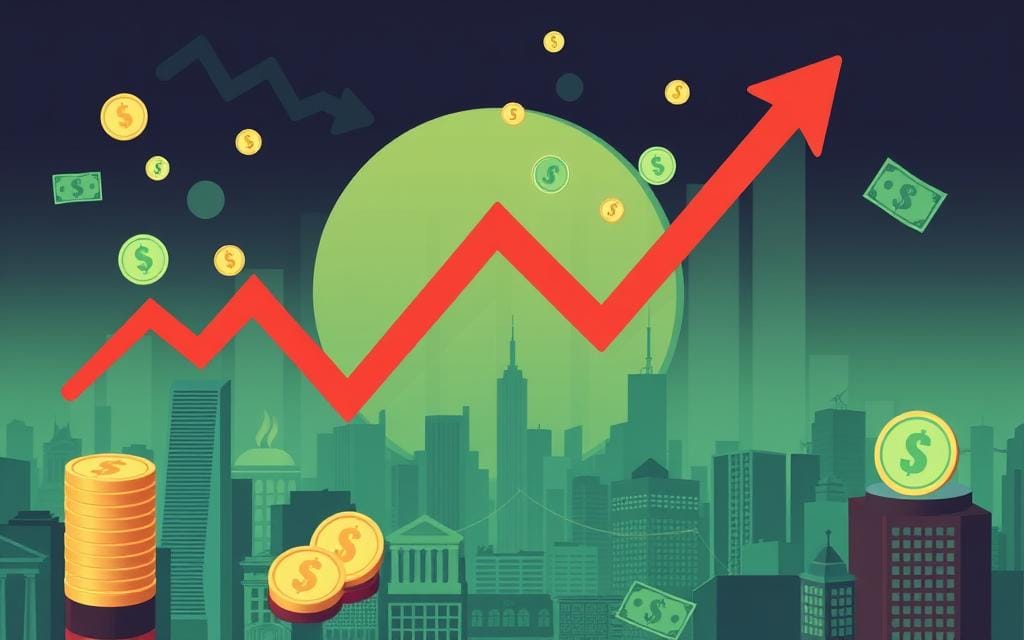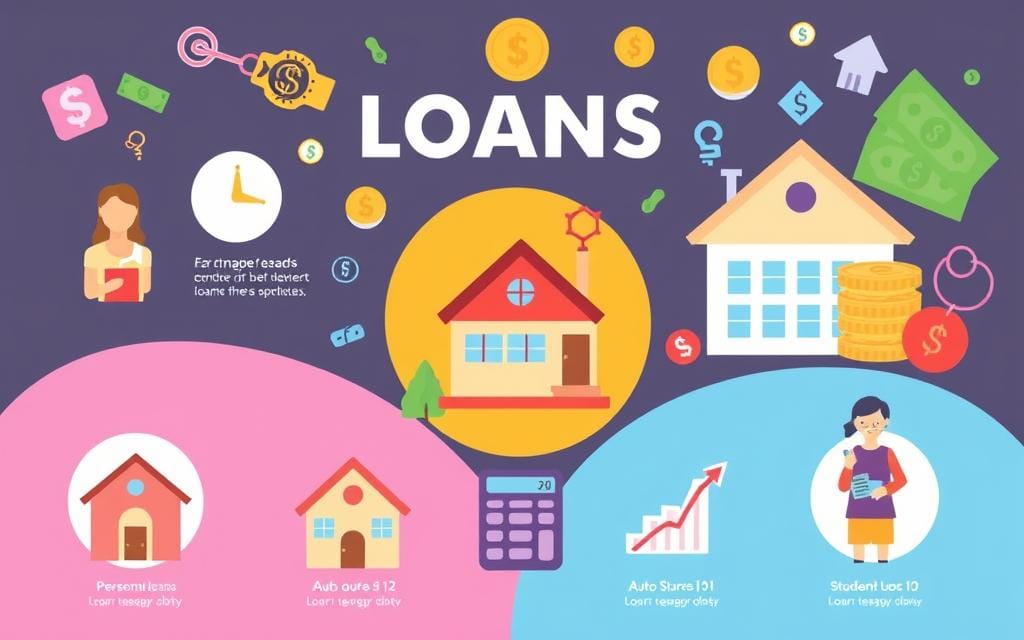advertisement
A small change in interest rates can have a big impact on loan payments. For example, a 1% shift can affect a $300,000 mortgage by $150 per month. Interest rates play a crucial role in shaping the financial world for everyone.
Understanding how these rates are set is key to navigating lending and borrowing. It helps people make smart financial choices and secure better deals.

Many factors influence loan interest rates in the US. These include economic indicators, Federal Reserve policies, and market trends. Credit scores also play a significant role in determining individual rates.
By learning about these key drivers, you’ll gain insights into the lending industry. This knowledge can help you find the best rates for your financial needs.
Understanding Interest Rates and Their Importance
Interest rates are fees charged by lenders for borrowing money. They represent the borrowing costs for loans, including loan interest or lending rates. Knowing about interest rates helps in making smart money choices.
Interest rates are key in loan agreements. They affect how much you’ll pay overall for borrowing money.
Definition of Interest Rates
Interest rates show the percentage charged on borrowed money. They’re usually given as an annual percentage rate (APR). This rate includes the total cost of borrowing for a year.
Types of Interest Rates
- Fixed interest rates: These rates stay the same throughout the loan. They help borrowers plan their finances better.
- Variable interest rates: These rates change over time. They often follow market conditions or benchmark rates like Prime Rate or LIBOR.
Importance of Interest Rates in Loan Agreements
Interest rates greatly affect loan costs. They determine monthly payments and the total amount repaid. The loan interest rate influences how affordable a loan is for the borrower.
Higher rates make loans more expensive. Lower rates can make them easier to get and pay back.
“Understanding interest rates is crucial for making informed financial decisions, as they directly impact the overall cost of borrowing.”
Major Factors Influencing US Loan Rates
US loan rates are influenced by various complex factors. Economic growth, inflation, and federal policies all play crucial roles. Understanding these drivers helps both lenders and borrowers make informed decisions.
Economic Growth Indicators
The US economy’s health significantly impacts loan rates. Strong growth, measured by GDP and employment figures, often leads to higher interest rates. During economic slowdowns, rates typically decrease to encourage borrowing and spending.
The Federal Reserve uses these indicators to guide its monetary policy decisions. These choices directly affect the cost of borrowing for consumers and businesses.
Inflation Rates
Inflation is a key factor in determining US loan rates. As prices rise, the Federal Reserve may increase the federal funds rate. This action aims to control inflation but also drives up borrowing costs.
Higher inflation often results in increased interest rates on various loan products. This relationship impacts everything from mortgages to personal loans.
Federal Reserve Policies
The Federal Reserve‘s decisions significantly shape US loan rates. By adjusting the federal funds rate, they influence the broader interest rate environment. These actions affect rates on mortgages, personal loans, and other financial products.
Lenders and borrowers closely monitor the Federal Reserve‘s actions. These policies greatly impact the factors affecting interest in the US loan market.
| Factor | Impact on US Loan Rates |
|---|---|
| Economic Growth | Higher growth leads to higher rates, while slower growth results in lower rates |
| Inflation | Rising inflation typically prompts the Federal Reserve to increase the federal funds rate, leading to higher loan rates |
| Federal Reserve Policies | The Federal Reserve’s adjustments to the federal funds rate directly influence the overall US loan rates environment |
Grasping these key factors helps in making smart financial choices. Consumers and businesses can better navigate the loan market. This knowledge enables them to secure the best possible terms and interest rates.
The Role of the Federal Reserve in Setting Rates
The Federal Reserve, or Fed, shapes interest rates in the United States. It uses the federal funds rate as a benchmark. This rate influences consumer loans and mortgages.
Federal Funds Rate Explained
The Federal Open Market Committee (FOMC) sets the federal funds rate. This group of economists and policymakers belongs to the Federal Reserve. They aim to promote employment and price stability.
When the federal funds rate rises, borrowing costs increase for consumers and businesses. This affects the broader economy.
Impact on Consumer Loans
The federal funds rate directly affects interest rates on consumer loans. These include auto loans, personal loans, and credit cards. Higher rates mean lenders charge more for borrowing.
When the rate decreases, consumers may enjoy lower interest rates on loans.
Influence on Mortgage Rates
Mortgage rates are indirectly tied to the federal funds rate. They’re influenced by bond market shifts driven by Fed decisions. Rising federal funds rates can lead to higher mortgage rates.
This makes home buying more expensive for potential homeowners.
Understanding the Fed’s role helps consumers make smart financial decisions. It guides them in navigating loans and managing existing debt.
Credit Scores and Loan Interest Rates
Your credit score greatly influences the interest rate on your loan. A good score can help you get better rates. Understanding this connection is key to reducing your borrowing costs.
How Credit Scores are Calculated
Credit scores consider payment history, credit use, and credit length. They also look at the types of credit you have. Lenders use these scores to judge lending risk.
Higher scores suggest lower risk to lenders. This assessment helps them decide on loan approvals and rates.
Impact of Credit Scores on Interest Rates
Higher credit scores often lead to lower interest rates on loans. Lenders see these borrowers as less risky. Lower scores may result in higher borrowing costs or loan denials.
Credit scores significantly affect factors affecting interest and borrowing costs. A good score is vital for getting the best favorable lending rates.
Check your credit report often. Fix any errors you find. Work on improving your credit over time. This knowledge helps you make smart choices about lending rates and borrowing costs.
Types of Loans and Their Interest Rate Structures
Loan interest rate structures are crucial when borrowing money. In the US, various loan options exist with unique interest rate compositions. Fixed versus variable and short-term versus long-term are two main categories.
Fixed vs. Variable Interest Rates
Fixed interest rates stay constant throughout the loan’s life. They offer predictable monthly payments, ideal for long-term financial stability. Borrowers can easily budget their expenses with fixed rates.
Variable interest rates change based on market conditions. The Federal Reserve’s loan interest benchmark influences these rates. Variable rates may start lower but can increase over time.
This impacts overall US loan rates and borrowing costs. Borrowers should consider their risk tolerance when choosing between fixed and variable rates.
Short-term vs. Long-term Loans
Loan durations vary from short-term (1-5 years) to long-term (up to 30+ years). Short-term loans usually have lower loan interest rates but higher monthly payments.
They’re good for minimizing borrowing costs. Long-term loans spread payments over a longer period, resulting in lower monthly installments.
However, overall US loan rates may be higher for long-term loans. Consider your financial goals when choosing between short-term and long-term options.
Knowing these loan structures helps borrowers make informed decisions. Choose a loan that fits your financial goals and preferences.

Market Conditions and Their Influence on Loan Interest
Factors affecting interest rates on US loan rates are closely tied to market conditions. Supply and demand dynamics impact borrowing costs. Investor sentiment also plays a crucial role in shaping interest rates.
Supply and Demand Dynamics
The lending market follows supply and demand principles. High loan demand with limited funds leads to higher interest rates. Low demand and abundant funds generally result in lower rates.
Economic growth, inflation rates, and federal policies drive these dynamics. As the economy grows, loan demand increases, pushing up US loan rates. During downturns, reduced demand can lower lending rates.
Investor Confidence and Its Effects
Investor confidence shapes interest rates on loans. Bullish investors lend at lower rates, driving down US loan rates. Less confident investors demand higher rates to offset perceived risks.
This can increase lending rates, making it harder to secure favorable US loan rates. Economic outlook greatly influences investor confidence and lending decisions.
“The interplay between economic factors and market sentiment is a key determinant of interest rate fluctuations in the lending market.”
Understanding supply, demand, and investor confidence is crucial in navigating loan interest rates. Staying informed about market conditions helps borrowers make smart decisions. This knowledge can lead to securing better US loan rates.
Comparison of Interest Rates Across Different Loan Types
Interest rates vary significantly across loan types. Understanding these differences helps consumers secure favorable terms for their financial needs. Let’s explore current trends in mortgage, auto, and personal loan rates in the US.
Mortgage Rates
US mortgage rates have been volatile recently. They fluctuate due to economic factors. The average 30-year fixed mortgage rate is around 6.5%, while 15-year fixed rates are about 5.8%.
These rates are influenced by Federal Reserve policies. Investor sentiment and housing market conditions also play a role.
Auto Loan Rates
Auto loan interest rates are typically lower than mortgage rates. This reflects shorter loan terms and vehicle collateral. The average rate for a 60-month new car loan is about 5.1%.
Used car loans have slightly higher rates, around 5.6%. Credit scores, loan amounts, and market competition affect these borrowing costs.
Personal Loan Rates
Personal loans often have the highest interest rates among major loan types. The average rate is currently around 10.3%. This is due to their unsecured nature.
Lenders closely assess personal loan applicants’ creditworthiness. Rates can vary widely based on credit score, income, and repayment history.
| Loan Type | Average Interest Rate |
|---|---|
| 30-year Fixed Mortgage | 6.5% |
| 15-year Fixed Mortgage | 5.8% |
| 60-month New Car Loan | 5.1% |
| Used Car Loan | 5.6% |
| Personal Loan | 10.3% |
Understanding interest rates, US loan rates, and borrowing costs helps consumers make informed decisions. This knowledge allows them to negotiate favorable interest rates for their specific needs.
Regional Variations in US Loan Rates
US loan interest rates differ across regions. Economic factors shape these disparities. The lending landscape offers valuable insights into these regional differences.
Comparison of Rates Across States
Loan rates vary significantly between states. Coastal states like California and New York often have higher rates. The Midwest and South tend to offer lower rates.
Several factors influence these differences. These include cost of living, local economic conditions, and lending market competition.
Urban vs. Rural Interest Rates
Urban and rural areas show distinct patterns in loan rates. Cities offer more lending options, leading to competitive rates. Rural communities face higher rates due to limited competition.
Lenders often view rural areas as higher risk. This perception contributes to the increased rates for rural borrowers.
| Region | Average Interest Rate |
|---|---|
| California | 7.2% |
| Texas | 6.5% |
| Illinois | 5.9% |
| Rural Areas | 8.1% |
| Urban Areas | 6.7% |
The table shows key regional variations in US loan rates. It highlights differences between states and urban-rural areas. This data helps borrowers make informed decisions when seeking financing options.
“Understanding the regional differences in loan interest rates is crucial for borrowers to secure the most favorable terms and avoid overpaying for their financing needs.”
Tips for Securing the Lowest Loan Interest Rate
Getting the lowest loan interest rate is vital. It reduces borrowing costs and maximizes loan value. Understanding key factors can help you make smart choices and negotiate better terms.
Importance of Shopping Around
To get the best rate, compare offers from many lenders. Don’t take the first offer you see. Look at rates, fees, and terms from banks, credit unions, and online lenders.
This helps you understand what affects interest rates. It also helps you find the most competitive option available.
Role of Loan Terms and Conditions
Loan terms and conditions greatly impact your interest rate. The loan amount, repayment period, and your credit profile all influence borrowing costs.
Review the fine print carefully. Try to negotiate the best terms possible. This can lead to big savings over time.
Shopping around and understanding loan terms are key. These steps can help you get the lowest rate and reduce costs.
Take time to research and compare options. It pays off in the long run. You’ll make a smarter choice and get the best deal possible.
Future Trends in US Loan Interest Rates
The US economy is changing, and loan interest rates may shift soon. Experts predict exciting changes for borrowers and investors in the coming years.
Predictions Based on Economic Indicators
Analysts watch factors like GDP growth, inflation, and Federal Reserve policies to predict interest rates. Many expect a slow rise in rates for mortgages, auto loans, and personal financing.
This is due to steady economic growth and the Fed’s focus on managing inflation. These changes will affect various lending sectors.
Impact of Geopolitical Events
Global events can greatly influence US lending markets. Trade tensions, political unrest, and energy price changes may cause interest rate fluctuations.
Borrowers and investors should stay informed about these trends. This knowledge will help them make smart financial choices in the future.
FAQ
What is the definition of interest rates?
Interest rates are the cost of borrowing money. They’re shown as a percentage of the loan amount. Lenders charge these rates for using their funds.
What are the different types of interest rates?
Interest rates come in various types. These include fixed rates, variable rates, and the federal funds rate. The Federal Reserve sets the federal funds rate.
Why are interest rates important in loan agreements?
Interest rates greatly impact the overall cost of borrowing. They determine how much interest is paid on loans. These rates can influence a borrower’s decision to take out a loan.
What are the major factors that influence US loan rates?
Key factors shaping US loan rates include economic growth indicators. Inflation rates and Federal Reserve policies also play a role. These elements work together to influence loan rates.
How does the Federal Reserve’s federal funds rate impact consumer loans and mortgage rates?
The federal funds rate affects consumer loan and mortgage rates. It’s the rate at which banks lend to each other. Changes in this rate can lead to shifts in other loan rates.
How do credit scores affect loan interest rates?
Credit scores are crucial in determining interest rates for borrowers. Higher credit scores often lead to lower interest rates. Lenders see these borrowers as less risky.
What is the difference between fixed and variable interest rates?
Fixed interest rates stay the same throughout the loan’s life. Variable rates can change based on market conditions. The federal funds rate can also affect variable rates.
How do supply and demand dynamics in the lending market influence loan interest rates?
Supply and demand in the loan market affect interest rates. High demand and low supply can lead to higher rates. Low demand and high supply may cause rates to decrease.
How do mortgage rates compare to auto loan and personal loan rates?
Mortgage rates are usually lower than auto and personal loan rates. This is because homes are seen as lower-risk assets. Lenders consider mortgages to be more secure.
Are there regional variations in US loan rates?
Yes, loan rates can vary across the United States. Local economic conditions play a role in these differences. Market competition and cost of living also contribute to regional variations.
What are some tips for securing the lowest possible loan interest rate?
To get the lowest rate, compare offers from multiple lenders. Understand the loan terms that can affect interest rates. It’s important to shop around and know what impacts your rate.



